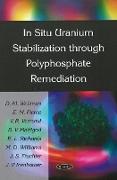- Start
- In Situ Uranium Stabilization Through Polyphosphate Remediation
In Situ Uranium Stabilization Through Polyphosphate Remediation
Angebote / Angebote:
The Hanford Site, in south-eastern Washington State, is a former nuclear defence production facility. A groundwater plume containing uranium, originating from a combination of purposeful discharges of wastewater to cribs, trenches, and ponds, along with some accidental leaks and spills with nuclear fuel fabrication activities, has persisted beneath the Hanford Site 300 Area for many years. The uranium plume is just upstream of the city of Richland municipal water supply intake on the Columbia River. Despite the cessation of uranium releases and the removal of shallow vadose zone source materials, the remedial action objective to lower the concentration of groundwater uranium to the U.S. Environmental Protection Agency (EPA) maximum contaminant level (MCL) concentration of 30 ¿g/L has not been achieved within the anticipated 10-year time period. Despite several decades of studies, effective uranium cleanup strategies remain elusive for contamination in deep subsurface settings that prevail at a number of U.S. Department of Energy (DOE) sites in the western United States. Numerous strategies have been proposed including iron barriers, soluble reductive agents, microbial stabilisation via reduction and precipitation, and emplacement of solid phosphate barriers. While these all have merit, each encounters limitations for deep subsurface remediation in an oxidative environment (Peterson et al. 2005, Wellman et al. 2005b, Wellman et al. 2006c, McGrail and Mattigod 1999, DOE 2005a, DOE. 2005b). Polyphosphate technology has been demonstrated to delay the precipitation of phosphate phases for controlled in situ formation of stabile phosphate phases which control the long-term fate of uranium (Wellman et al. 2005b, Wellman et al. 2006c). Precipitation of phosphate minerals occurs when phosphate compounds degrade in water to yield the orthophosphate molecule (PO43 ). Accordingly, a detailed understanding of polyphosphate degradation and reaction kinetics, in the context of site-specific information, allows the technology to be tailored as a time-released source of phosphate for direct subsurface treatment without a drastic change in hydraulic conductivity of the target aquifer. A site-specific treatability test was conducted to optimise polyphosphate remediation technology for implementation through a pilot-scale field technology demonstration to accelerate monitored natural attenuation of the uranium plume within the Hanford 300 Area aquifer. A focused application of polyphosphate was conducted in a source or "hot spot" area to reduce the inventory of available uranium that contributes to the groundwater plume through direct precipitation of uranyl-phosphate solids and secondary containment via precipitation of apatite acting as a long-term sorbent for uranium. The general treatability testing approach consisted of initial site characterisation and set-up, a polyphosphate injection test, and post-treatment performance assessment. Fundamental science studies were conducted with site- specific sediment and groundwater to develop an effective remediation scheme for deployment of polyphosphate technology. In addition to remediating a portion of the plume, the data from this test provide valuable information for designing a full-scale remediation of uranium in the aquifer at the 300 Area of the Hanford Site. Results provide a detailed understanding of the fundamental underpinnings necessary to evaluate the efficacy and potential use of polyphosphate technology at other sites with varying geochemical and hydrodynamic conditions.
Folgt in ca. 10 Arbeitstagen

